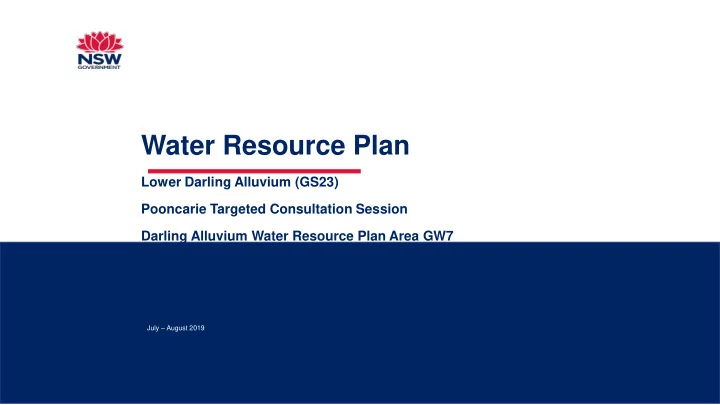

Water Resource Plan Lower Darling Alluvium (GS23) Pooncarie Targeted Consultation Session Darling Alluvium Water Resource Plan Area GW7 July – August 2019
Water resource plans – achieving Basin Plan outcomes Communities with sufficient and reliable water supplies that are fit for a range of intended purposes, including domestic, recreational and cultural use Productive and resilient water-dependent industries, and communities with confidence in their long-term future Healthy and resilient ecosystems with rivers and creeks regularly connected to their floodplains and, ultimately, the ocean.
NSW context – WRPs and NSW Commonwealth Water Act 2007 Water Sharing Plans Murray – Darling Basin Plan 2012 Water resource plans Specify the rules for diverting water Relevant parts of a NSW Water Management Act 2000 within specified areas of the Murray – water sharing plan Darling Basin. are assessed by the Water sharing plans MDBA, accredited by Specify the rules for sharing water Elements include: the Commonwealth to maintain the health, sustainability • Compliance with the sustainable Minister and form and productivity of surface water part of the water diversion limits and water trade rules and groundwater sources across all resource plan. • Protection of water for the of NSW. environment • Water quality and salinity objectives • Aboriginal values and uses Water Sharing Plans remain the primary • Measuring and monitoring • Arrangements for extreme events statutory instruments for water sharing in NSW
Process for developing the water resource plan DEVELOP CONSULT APPROVE & ACCREDIT IMPLEMENT Status Strategy Draft Public Final Ministerial MDBA WRP & Issues & rule WRP exhibition WRP approval assessment & Commences paper development WRP Commonwealth Minister May 2017 July/August accreditation 2020 2019
The Darling Alluvium water resource plan
Proposed changes to the water sharing plan The plan has been revised to: • Align with requirements of the Basin Plan and the water resource plan • Be more ‘readable’ • Be more legally robust • Include all alluvial groundwater sources of the Darling catchment • Address inconsistencies between similar water sources
Proposed changes to the water sharing plan • Align long term average annual extraction limits to Basin Plan sustainable diversion limits • The Lower Darling long-term average annual extraction limit has increased to include a volume for salinity management (salt interception scheme). LTAAEL was 1,529 ML now 2,230 ML
Proposed changes to the water sharing plan Additional provisions for assessing compliance • At end of each water year – 2 assessments of compliance: • First as per current arrangements comparing five year rolling average use with LTAAEL (long term average annual extraction limit in WSP). • Second comparing extraction in the previous year to a theoretical and retrospectively calculated ‘ annual permitted take ’ as required under Basin Plan provisions to assess compliance with the sustainable diversion limit (SDL).
Proposed changes to the water sharing plan Additional provisions for assessing compliance with the sustainable diversion limits under the Basin Plan • Directly references compliance provisions in the Basin Plan • Running balance of ‘credits’ and ‘debits’ accumulating for each year • Compliance triggered if running balance is 20% below the Basin Plan ‘sustainable diversion limit
Lower Darling Alluvium extraction 2.5000 Take (GL) 2.0000 BLR SDL or LTAAEL Extraction - Gigalitres 1.5000 LTAAEL Compliance Assessment 5 year average take 1.0000 0.5000 0.0000 2012/2013 2013/2014 2014/2015 2015/2016 2016/2017 2017/2018
Proposed changes to the water sharing plan If long term average annual extraction limit or sustainable diversion limit is breached the Minister can: • Reduce the available water determination for aquifer access licences the following year (as per current water sharing plan), and/or • Limit the water allocation that can be taken, assigned under section 71T of the Commonwealth Water Act 2007 , or otherwise debited or withdrawn from a water allocation account of an aquifer access licence. • Only makes a difference in groundwater sources where allocations can be ‘carried over’ from one water year to the next. Access licences in the Darling Alluvium do not permit carryover.
Proposed changes to the water sharing plan Groundwater dependent ecosystems • Additional high probability, high priority groundwater dependent ecosystems mapped for all areas and included as a Schedule in the water sharing plan. See map available for inspection at this meeting.
Proposed changes to the water sharing plan Rules to minimise interference between users Distance from: Production bores 400m Neighbours works (production and basic rights) Neighbours works (boundary - without consent) 200m 500m A water utility bore (unless consent provided)
Proposed changes to the water sharing plan Additional rules to reduce risks to groundwater from contamination sources Unless bores are constructed to be isolated from contamination source • Distances of new bores from edge of plumes. • Distances from septics.
Proposed changes to the water sharing plan Amendment provisions • Allowing for inter-state trading rules to be developed and implemented. This can only occur if and when appropriate administrative arrangements are in place. • Allowing for modifications to sustainable diversion limits and long- term average annual extraction limits to be modified as a result of better information or change in factors use to set limit.
Proposed changes to the water sharing plan Access rules • Rule for groundwater access to provide for survival of permanent plantings when low surface water allocations. • Feedback from stakeholders is that the provisions as currently written prevent access at critical times. • Further feedback is sought on how these rules may be amended to improve workability while still achieving the original intent.
Have your say • Water Resource Plan Public Exhibition period until 23 August 2019. • Feedback being sought from the public and water users • Online submission process on Department of Industry website: https://www.industry.nsw.gov.au/water/plans-programs/water-resource- plans/drafts/darling-alluvium • By email: darling.gw.wrp@dpi.nsw.gov.au
Recommend
More recommend